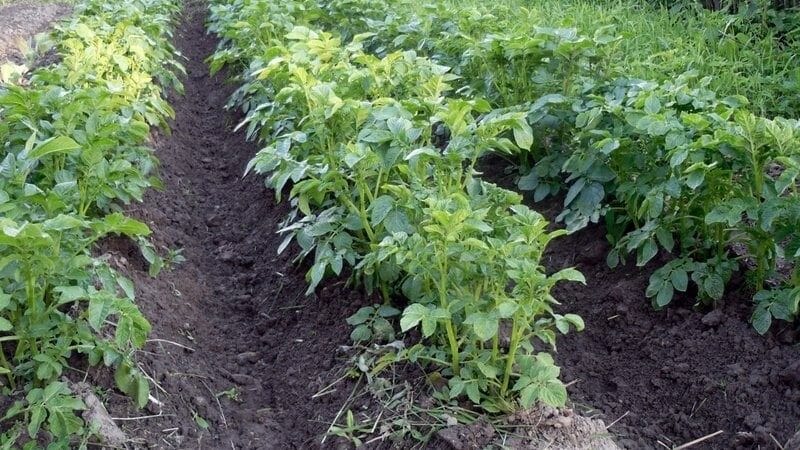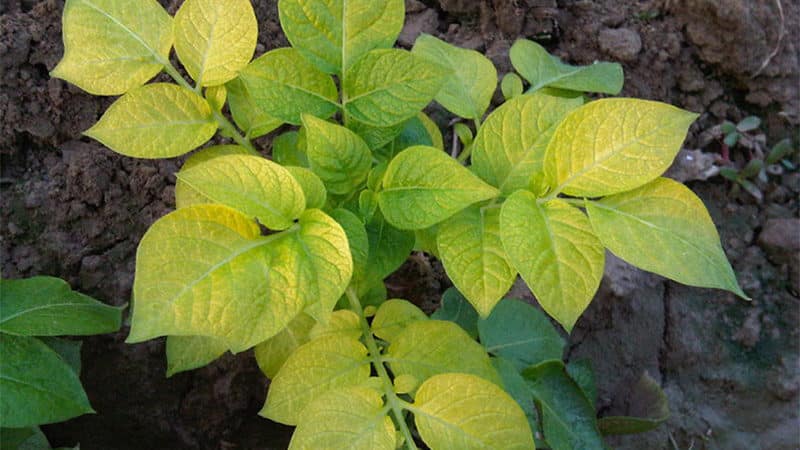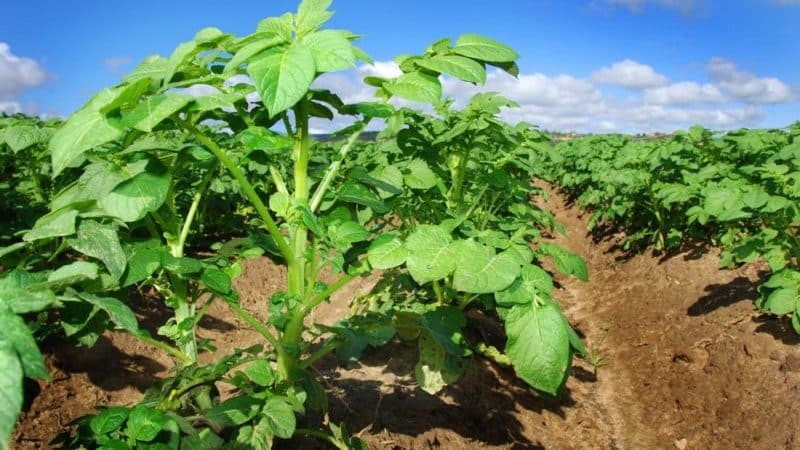How to properly trim the tops of potatoes and why it is necessary
Many farmers mow down the tops of their potatoes. Some do this to increase yield, others to fight diseases. In any case, it is important to carry out the procedure correctly and use the resulting waste wisely. Timely cutting of the tops contributes to the accumulation of starch, thickening the peel and improving the taste of the tubers. Green mass is used in the garden as a source of nutrients and material for mulching fruit and berry trees. Let's take a closer look at when to mow potato tops and why.
Why do they trim the tops of potatoes?

There are several reasons for removing potato tops:
- tubers ripen faster and receive more nutrients;
- drying of soil between rows is accelerated;
- potato skins become rough;
- the risk of late blight infection is minimized.
If the tops are not cut, it is convenient to determine the degree of maturity of the potatoes by using them: before harvesting, summer residents make sure that the green mass has completely withered.
How to trim the tops correctly
Compliance with the recommendations during the procedure will have a positive effect on the quality of the crop.
How to remove potato tops:
- Cut the tops with a sharp garden knife or scythe.
- The height of the basal stem remaining after pruning should not exceed 15 cm.
- The procedure is divided into 2 stages: 3 weeks before harvesting, the tops are removed, a week later the stems are shortened.
- The cut grass is dried and used as fertilizer.
- Diseased leaves and stems are burned.
When deciding to trim the stems, it is important to consider the purpose of further use of the potatoes.
When consuming young tubers, mowing the tops is not required. The tubers will grow with thin skin and low starch content. For long-term storage of vegetables, you will need to remove the tops. In this case, the tubers will form a thick skin and accumulate starch.
This is interesting:
Life hacks from experienced farmers: why pick flowers from potatoes and what does it give?
Reasons for tops drying out and whether potatoes grow after this
When to trim the tops
At the stage of bud formation and during the flowering period potato feed with complex fertilizer “Aquarin” (10 g of the drug is diluted in 10 liters of water) or nettle infusion. This will allow the plants to accumulate nutrients, which, after removing the tops, will feed the tubers.
Nettle infusion is prepared a month before planned use.
Instructions:
- 1 kg of nettle leaves and stems are crushed.
- The resulting raw materials are placed in a bucket and 10 liters of water are poured.
- The bucket is covered with a lid, the mixture is left to ferment for 30 days.
- The infused composition is filtered through a sieve.
- Before use, the infusion is diluted with water in a ratio of 1:10.
Step-by-step scheme for processing potatoes:
- Before starting work, dilute the fertilizer according to the instructions.
- Pour the resulting mixture into the sprayer.
- In the morning or evening in dry, windless weather, treat the bushes: spray the leaves and stems on all sides.
- Repeat the procedure after 14 days.
It is optimal to trim the tops 30 days after flowering ends. The main prerequisite for starting the procedure is stems that have turned yellow by more than 50%.
The exact timing of pruning is determined by the potato variety and weather conditions.Early varieties ripen in the second half of August, late ones in mid-September. For the latter, pruning is carried out at least 21 days before the first frost.
Reference. If the purpose of growing bushes is to obtain seed tubers, the tops are cut off 3 weeks after flowering has completed.
When affected by late blight, the tops are cut off immediately. This will prevent the infection from spreading to the tubers and soil.
Mowing when leaves are damaged
Late blight disease of leaves and stems allows you to deviate from the rules and timing of pruning. Harvest rescue immediately when:
- leaf damage;
- cold nights, morning fogs and dew.
Late blight on potatoes comes from the soil in which the mycelium with spores lives. With alternating drizzling rains and scorching sun, along with cool nights and morning dew, late blight actively develops.
Signs of the disease:
- dark brown spots on the foliage, rapidly increasing in size;
- gray coating on affected leaves;
- blackening of green mass, drying of stems.
Harvested tops with signs of disease are removed from the site and burned.
Do potatoes grow after mowing the tops?
Removing green mass entails stopping the growth of tubers.
At the same time, a number of useful accompanying processes are noted:
- vegetables accumulate nutrients;
- the peel begins to harden;
- the soil between the rows dries out.
If you mow the tops, will potatoes grow? Although the tubers will stop growing, they will be saturated with nutrients, and their shelf life will increase during long-term storage.
Reasons for intensive growth of tops
A large green mass of potatoes is characteristic of varieties with a low starch content. In other cases, it indicates an imbalance.
Timely identification of the cause of active growth of tops and taking preventive measures will save the harvest.
Excess nitrogen
This is the most common cause of top growth. Excess nitrogen is formed from the use of mullein, humus, bird droppings, and compost in the spring and autumn as fertilizers.
Large tubers
The tops can grow if the planting material is chosen incorrectly. Tubers the size of a chicken egg are considered optimal. Large potatoes for landings will bring big tops, not a rich harvest.
Interesting! In large areas it is convenient to use a potato topper.
There are a lot of nutrients in large seed material. This allows the stems and foliage to feed from the mother tuber for a long time, slowing down the growth of roots and stolons.
Lack of light

Shade and partial shade lead to increased growth of green mass. With a lack of light, the plant stretches out in search of it, the stems become thin, the leaves become small.
Another reason for the lack of light is dense plantings of tubers. In pursuit of high yields, farmers plant seeds close together. The effect is the opposite: the tubers become smaller, the stems stretch.
Weather
The optimal conditions for growing potatoes are warm, sunny weather at +22…+26°C. If such a temperature is accompanied by a lot of rain, intensive growth of tops cannot be avoided.
What to do if the tops are high
If tall tops are not typical for a variety, this is a reason to worry.
Prevention measures:
- Excess nitrogen is removed by reducing nitrogen fertilizing (compost, humus, etc.) and increasing phosphorus. A superphosphate solution is well suited (100 g of the drug is diluted in 10 liters of water).The prepared mixture is generously sprayed onto the bushes in the morning or evening in dry weather.
- With the lack of lighting, the problem will be solved for the next season. It is recommended to reconsider the planting location, optimally sunny location.
The tops are low

Low tops are not a reason to worry if the characteristics of the variety do not suggest its growth. It’s another matter if the cause of the low green mass of potatoes is diseases.
Black scab (rhizoctoniosis) affects all parts of the plant. Black growths or depressed dark spots are visible on the tubers. In warm and humid weather, a whitish coating (dry rot) appears on the stems. The leaves curl at the top, and airy green tubers grow in the axils.
Preventive measures include calcining the seed material in the sun until a green tint appears and later planting in the ground. Treatment of infected bushes is determined by their growth phase. When the stems grow, the plants are watered with liquid mullein (500 g diluted in 10 liters of water, 0.5 liters are spent per bush). In the flowering phase 2 tbsp. Mullein is diluted in 10 liters of water, 0.5 liters of the composition are added to 1 plant.
Brown bacterial rot manifested by wilting of leaves. The foliage turns greenish-bronze, then curls and falls off. The stems turn brown and rot at the base. When cut, the tubers have whitish rings. When pressed, they release viscous brown mucus.
Methods for destroying brown rot are ineffective. They fight the disease by completely renewing the seed material, timely weeding (every 2 weeks), and observing the rules of crop rotation. The best crop predecessors are cucumbers, cabbage, legumes, and pumpkins.
Fluoride deficiency is indicated by a purple ring on the cut of a young tuber. Replenish the lack of nutrients with superphosphate. To do this, dissolve 100 g of the drug in 1 liter of water, leave for a day, then add another 9 liters of water. The resulting solution is poured into a spray bottle and sprayed once in the morning or evening in dry weather.
Using cut tops
The removed green potato mass is used in garden plots as mulch, ash, and compost.
Important! For these purposes, take healthy tops, without signs of disease.
Mulching is carried out in late autumn. The trunk circles of fruit trees are covered with a layer of tops, 50–75 cm away from the trunk. For young plants, a mulch thickness of 5–6 cm is sufficient, for adults – 8–10 cm.
To prepare phosphorus-potassium fertilizer, the tops are burned in an iron barrel. After cooling, the resulting ash is collected in a dry container, covered with a lid and stored in a dry place.
Ash is added when digging up a site in spring or autumn (100–200 g per 1 m²) or 1 tbsp is added. l. into the holes before planting.
Compost is prepared in a box, trench or heap according to the following scheme:
- Choose a shady place, away from buildings.
- 20 cm of peat or leaves are poured onto the bottom, and 2-3 cm of soil on top.
- Next, 15–20 cm of tops are laid.
- Cover all 3 cm of soil mixed with ash. Add 2 tbsp to a bucket of soil. l. ash.
- The materials are alternated until the pile reaches 1.5 m in height.
- To speed up the process, each layer of soil is watered with 1 liter of slurry.
- Lay 5 cm of peat or soil on top.
- In dry weather, the pile is watered; during rains, it is covered with film.
- Compost ripening time is from 6 months to 2 years. Readiness is determined by the smell of earth and a loose brown mass.
Apply compost before planting: add it directly to the holes, 1 liter per hole, or during digging (1 bucket per 1 m²).
Conclusion
It is important to cut the tops in a timely manner, on average 30 days after flowering ends. Greens are not thrown away, but are usefully used as fertilizer in the garden.
If you correct agricultural mistakes that lead to active growth of green mass, the harvest can be saved. So, there will be no high tops if you choose a sunny place for planting, maintain a distance of 40–50 cm between tubers, and use manure as a top dressing once a year, in spring or autumn.